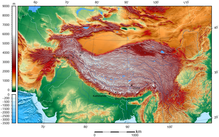High-mountain Asia (HMA) is a high-elevation[1] geographic region in central-south Asia that includes numerous cordillera and highland systems around the Tibetan Plateau, encompassing regions of East, Southeast, South and Central Asia. The region was orogenically formed by the continental collision of the Indian Plate into (and underneath) the Eurasian Plate.

According to NASA, the region is the "world's largest reservoir of perennial glaciers and snow outside of the Earth's polar ice sheets",[2] and has been nicknamed the "Third Pole". Their meltwaters and runoffs form the headwaters of river systems that support the drinking water and food production of nearly 3 billion people, and hydrological and climate changes in the mountains affect "ecosystem services, agriculture, energy and livelihood"[3] for all the surrounding areas.[4][5] NASA has a High Mountain Asia Team (HiMAT) to study the region.[3]
In a 2020 study, the term High Asia or High Mountain Asia was used metaphorically to categorise Kashmir, Hazara, Nuristan, Laghman, Azad Kashmir, Jammu, Himachal Pradesh, Ladakh, Gilgit Baltistan, Chitral, Western Tibet, Western Xinjiang, Badakhshan, Gorno Badakhshan, Fergana, Osh and Turkistan Region. These rich resource areas are surrounded by the five major mountainous systems of Tien Shan, Pamirs, Karakoram, Hindu Kush and Western Himalayas and the three main river systems of Amu Darya, Syr Darya and Indus. The work further highlighted the role of United States, China, Russia, UK, India, Pakistan, Afghanistan, Kazakhstan, Uzbekistan, Kyrgyzstan, Tajikistan, Turkey, Iran and other players involved in The New Great Game over who will dominate High Asia in the 21st century.[6]
Geography
editHigh-mountain Asia is centered around Tibetan Plateau (a.k.a. the "Roof of the World"), and extends to the surrounding regions as numerous mountain ranges:
- south – the Himalayas and Arakan Mountains;
- southeast – the Hengduan Mountains, Yun-Gui Plateau and Shan-Tenasserim ranges;
- east – the Qinling Mountains and various ranges that edge the Sichuan Basin;
- north – the Qilian Mountains, Kunlun Mountains, Tian Shan ranges and (arguably) Altai Mountains as well as parts of the Mongolian Plateau;
- northwest – the Pamir-Alay and Pamir Mountains;
- west and southwest – the Karakoram, Hindu Kush and Sulaiman-Kirthar Mountains.[7][5]
These mountain range networks contains all 14 peaks above 8,000 m (26,000 ft) and all of the peaks above 7,200 m (23,600 ft), and expand across the mountainous Chinese provinces of Tibet, Xinjiang, Sichuan and Yunnan (including the flat and depressed Tarim Basin in southern Xinjiang, which contains China's largest desert, the Taklamakan),[8] northern Myanmar, the Himalayan nations of Nepal and Bhutan as well as north/northwestern Pakistan and northeastern India, and most of the southeastern Central Asian nations of Kyrgyzstan, Tajikistan and Afghanistan. Their rain shadows are partly responsible for the cold arid climate in parts of Central Asia and the Mongolian Plateau.
References
edit- ^ Qiu, Jane (January 27, 2015). "High-Altitude Forests in the Himalayas Harder Hit by Droughts". Scientific American. Retrieved July 25, 2017.
- ^ Arendt, Anthony (December 2, 2016). "NASA Research Announcement: Understanding Changes in High Mountain Asia". NASA Solicitation and Proposal Integrated Review and Evaluation System. Retrieved July 25, 2017.
- ^ a b "Dr. Viviana Maggioni Receives Two Awards from NASA to Study Hyper-Resolution in Soil Moisture Land Modeling and Data Assimilation". George Mason University. 2016. Retrieved July 26, 2017.
- ^ International Symposium on Glaciology in High-Mountain Asia (PDF), International Glaciological Society, July 2014, retrieved July 25, 2017
- ^ a b Pritchard, Hamish D. (May 22, 2017). "Asia's glaciers are a regionally important buffer against drought". Nature. 545 (7653): 169–174. Bibcode:2017Natur.545..169P. doi:10.1038/nature22062. PMID 28492255. (Retracted, see doi:10.1038/nature25779, Retraction Watch)
- ^ Sharma, Vishal (2020). Civilizational Colonialism and the Ongoing New Great Game in the Sensitive Areas of High Asia: Exploring Pan-High Asianism as the potential way forward for the Western Pahari, Greater Dardic, Trans-Himalayan, Badakhshan and Sogdiana Belts possibly leading to High Asian Approaches to International Law (HAAIL). Academia.edu (Thesis). Cardiff: Cardiff University. Retrieved 2021-09-27.
- ^ "NASA High Mountain Asia Project". University of Washington eScience Institute: NASA High-Mountain Asia Project. Retrieved July 25, 2017.
- ^ Song, Chunqia; Huang, Bo; Ke, Linghong; Ye, Qinghua (October 2016). "Precipitation variability in High Mountain Asia from multiple datasets and implication for water balance analysis in large lake basins". Global and Planetary Change. 145: 20–29. Bibcode:2016GPC...145...20S. doi:10.1016/j.gloplacha.2016.08.005.